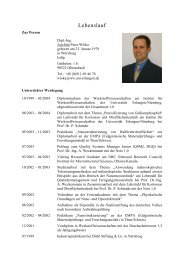Laboratory Safety Instruction - LKO
Laboratory Safety Instruction - LKO
Laboratory Safety Instruction - LKO
Create successful ePaper yourself
Turn your PDF publications into a flip-book with our unique Google optimized e-Paper software.
5. Work and protective clothing<br />
In the laboratory only wear appropriate clothes:<br />
- sufficiently long laboratory coat with long sleeves from cotton or Poly Cotton<br />
- closed and firmly treating footwear<br />
Do not wear clothes from plastic (e.g. nylon) in the laboratory, because it is easier inflammatory than<br />
cotton or Poly Cotton.<br />
Additional use the following protective gear:<br />
- protective glasses with side protection when you (or even other persons) start to handle hazardous<br />
materials in the laboratory;<br />
persons with eye-glasses have to use additional eyewear, e.g. safety goggles or face shields. (Very<br />
suitable are spectacles with corrective lenses; for the procurement and for financial support address<br />
the occupational safety office (SG Arbeitssicherheit, see Appendix)).<br />
- protective gloves when starting work with hazardous materials which can be absorbed by skin or<br />
which are very toxic, toxic, strike-attractive, corrosive, causing allergies, carcinogen, reproductionendangering<br />
or mutagenic.<br />
The gloves have to be sufficiently resistant against the used chemicals (resistance specification is<br />
provided in the catalogues of relevant manufacturers) and have to be consistent with the European<br />
<strong>Safety</strong> Standards ("CE"-label, pictogram, performance indices and customs information on packing).<br />
At the institute/professorship / in the laboratory for handling the listed hazardous materials the<br />
following protective gloves are available:<br />
…………………………………………………………………………………………………………………<br />
(the occupational safety office (SG Arbeitssicherheit) provides information and helps with<br />
selection of suitable protective gloves)<br />
- Protective shoes with antistatic sole, especially if there is an increased risk that electrostatic<br />
charge unloads and effects ignition of easily inflammatory or explosive substances (especially while<br />
working with inflammatory liquids, solvents, easy-inflammatory gases or other dangerous materials).<br />
Road shoes usually do not have sufficient conductivity.<br />
The protective clothing is provided by the institute.<br />
6. Emergency and safety equipment<br />
The employees of the laboratory have to know location and how to handle the following equipment:<br />
- the taps of permanent installed gas mains within the laboratory and the mains tap ("Gas-Notaus") of<br />
the gas supply to the laboratory<br />
- the master switch of the electrical supply to the laboratory<br />
- the mains tap of the water supply to the laboratory<br />
- the safety showers<br />
- the eye wash<br />
- the fire extinguisher, dousing blankets and sand extinguisher<br />
- the First Aid box<br />
- the chemical binder (absorption granulates, mercury bonding agent, etc..).<br />
Manipulations to the medium supply of the laboratory shall only be done in case of emergencies. If<br />
thereby occurs an interruption of the medium supply the concerned personnel has to be informed. Note,<br />
that the sudden interruption of the medium supply can sometimes increase danger. The special<br />
operating instructions for dangerous works regulate details.<br />
After interventions into the gas, electrician and water supply in course of an emergency address the<br />
technical office (Technischer Dienst, Tel. - 27777).<br />
4



